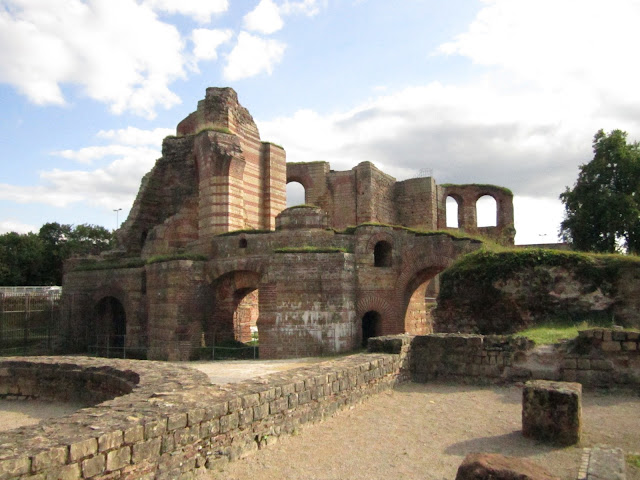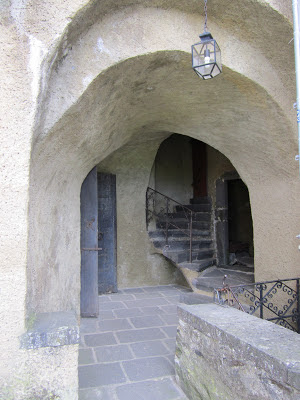On Wednesday, September 21, we left the Rhine valley and headed to the nearby Mosel river valley. The Mosel valley region is similar to the Rhine valley - both are known for their wine (mostly whites, Riesling in particular), colorful half-timber houses, and hilltop castles. But the Mosel is a narrower, more winding, and slower moving river with considerably less barge traffic, so it's supposed to be even more romantic!
We had breakfast at the hostel and again bought two lunches to go. Then we checked out, said goodbye to our lovely castle hostel, and hiked down to the hill to the train station. The train ride from Bacharach to Cochem, where we'd be spending the night, took just an hour and a half and we only had to change trains once. In Cochem, we checked into a sunny little B&B called Gasthaus zum Frohlichen Weinberg.
After getting settled into our room, we went out to explore the town. Cochem is bigger and busier than Bacharach or St. Goar, so it was lots of fun to just wander the streets and get lost.
We wandered down to the river front and saw the sleepy Mosel river. It is indeed very romantic!
We also did some wine tasting at a place recommended by Rick Steves. We sampled eight different white wines, but didn't find any we really liked. However, we discovered Federweißer - young wine, only three days old. They sell it all over in Cochem, and a couple vendors were offering free samples on the street. We tried some and it was surprisingly good! Tangy, sweet, and very inexpensive (just €2,60 per liter), so we bought a bottle and took it back to our room for later.
 |
| Where we did our wine tasting |
Day 6
On Thursday, September 22, we took a day trip to Trier, another city in the Mosel river valley, by train.
Trier is Germany's oldest city. It was founded by Augustus in 15 BC! At one time, it was used as the capital of the Roman empire.
In the fourth century, Trier had four great gates. Today, only one - the Porta Nigra (black gate) - survives. It's quite an impressive site!
We walked down the main pedestrian drag to the market square. The square was crowded and bustling with people. Vendors were selling fresh produce and flowers. We bought some lunch and sat on the steps of the market cross to people watch while we ate.
Then we toured the cathedral, which is the oldest one in Germany. According to Rick Steves, "St. Helena, the mother of Emperor Constantine (who legalized Christianity in the Roman Empire), let part of her palace be used as the first church on this spot. In 326, to celebrate the 20th anniversary of his reign, Constantine began the construction of St. Peter's in Rome and this huge cathedral in Trier."
Next we visited the enormous basilica - 100 feet tall and 200 feel long! It was originally constructed as the Roman emperor's throne room, and later turned into a church. It's the largest enclosed Roman structure still standing anywhere in the world. Sadly, it was badly damaged in World War II, but has since been reconstructed and restored to the original Roman style. It was neat to imagine how spectacular this building would have looked in Roman times, covered in colorful frescoes, marble and gold. It must have been amazing!
Finally, we went to the Imperial Roman Baths, one of the largest Roman baths in the world. A good portion of the structures are still intact. There's also a large complex of tunnels underground which were used for heating the bath water and saunas above. Exploring the tunnels was one of the highlights of the day!
Day 7
On Friday, September 23, we took another day trip from Cochem - this time to Burg Eltz, one of the few medieval castles still standing in its original form! Remarkably, it has never been seriously damaged, even in World War II.
Getting to Burg Eltz was kind of an adventure in itself. First, we took a short 20 minute train ride to the small town of Moselkern. Then we walked from the train station through the little town of Moselkern. Finally, we hiked through the woods outside Moselkerm up to Burg Eltz. The entire walk took a little over an hour (maybe 70 minutes up, 60 back down). It was mostly flat, with stairs or an incline every so often. Luckily, Rick Steves had easy to follow directions in his book so it wasn't difficult to find.
Once we reached the castle, we bought our tickets then waited about half an hour for the next English speaking tour. We went through the small treasury museum while we waited.
The tour was really informative! We ended up being the only two people on the English speaking tour, so that was cool. We learned that there were three Eltz family sons who together built the castle for their families, so each one got one wing of the castle. It has stayed in the Eltz family all these years! One of the branches of the family died out, and another became poor and sold their share of the castle to the third branch. But that branch of the Eltz family still lives there. So you can only tour part of the castle because the other rooms are really their home! However, the room we did get to see were really neat - they were even furnished with lots of old, original furniture. They did not allow pictures inside the castle unfortunately.
After our tour, we had a quick meal at the castle cafeteria, then hiked back down to the train station and returned to Cochem.



















































Gosh Germany is very beautiful.!!
ReplyDelete